This article needs additional citations for verification .(January 2021) |
The Tatra 602 Tatraplan Sport is a racing car produced by Tatra in 1949.
Contents

This article needs additional citations for verification .(January 2021) |
The Tatra 602 Tatraplan Sport is a racing car produced by Tatra in 1949.

The Tatra 602 was manufactured by Tatra based on the 600, built in 1949. The T602 Tatraplan-Sport was prepared by the Czech coachbuilder Sodomka. The 602 was a two-door sports car with possibly only two units built. The body is constructed from a lattice structure of steel tubes over which lightweight duralumin bodywork is placed. The car is powered by a mid-engine 1.9L 4-cylinder engine with four carburetors producing around 63 kW (84 hp). [1] [2] Power was sent to the rear wheels through a 3-speed manual transmission. [3]

The Tatra 602 was driven by Bruno Sojka at Brno for the 1949 Czechoslovakia Grand Prix. The 602 proved successful and won many races from 1950 to 1952, including the Ecce Homo hill race in 1950. On September 30, 1951, the 602, with Bruno Sojka at the wheel, crashed while training for the 1951 Ecce Homo hill race, killing Sojka. Although a cause was never determined, eyewitnesses stated that Sojka was hit in the face by a large bird.
Another 602 was built in 1951 and featured a 2.5L air-cooled V8 engine (from the Tatra 603) producing around 99 kW (133 hp) connected to a 4 speed manual transmission. [4] This 602 was destroyed in a 1953 crash while attempting a speed record, but the driver, Josef Chovanec, was thrown clear and survived. The 602 was later restored and competed in historic auto races. Unlike the original car, the 602 now has a sheet metal body and is powered by a Tatra 603 engine.
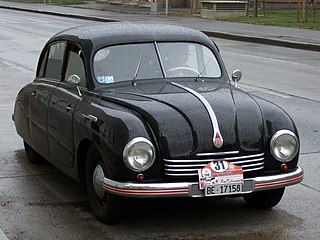
The Tatra 600, named the Tatraplan, was a rear-engined large family car produced from 1948 to 1952 by the Czech manufacturer Tatra. The first prototype was finished in 1946.

Tatra is a Czech vehicle manufacturer from Kopřivnice. It is owned by the Tatra Trucks company, based in Ostrava, and it is the third oldest company in the world producing cars with an unbroken history. The company was founded in 1850 as Ignatz Schustala & Comp., in 1890 renamed in German Nesselsdorfer Wagenbau-Fabriksgesellschaft when it became a wagon and carriage manufacturer. In 1897, Tatra produced the first motor car in central Europe, the Präsident automobile. In 1918, it changed its name to Kopřivnická vozovka a.s., and in 1919 it changed from the Nesselsdorfer marque to the Tatra badge, named after the nearby Tatra Mountains on the Czechoslovak-Polish border.
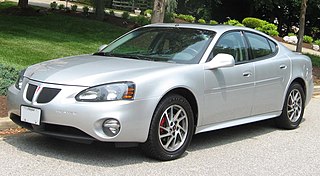
The Grand Prix is a line of automobiles produced by the Pontiac Division of General Motors from 1962 until 2002 for coupes and 1989–2008 for sedans. First introduced as part of Pontiac's full-size car offering for the 1962 model year, the model varied repeatedly in size, luxury, and performance during its production. Among the changes were positioning in the personal luxury car market segment and mid-size car offering from the second generation to the fifth generation for the sedan and from the second generation to the sixth generation from the coupe. The Grand Prix returned to a full-size car from the sixth generation to the seventh generation for the sedan, positioned below the larger Bonneville in Pontiac's model lineup.

The Dodge Challenger is the name of three different generations of automobiles produced by American automobile manufacturer Dodge. However, the first use of the Challenger name by Dodge was in 1959 for marketing a "value version" of the full-sized Coronet Silver Challenger.

The Pontiac Grand Am is a mid-size car and later a compact car that was produced by Pontiac. The Grand Am had two separate three-year runs in the 1970s: from 1973 to 1975, and again from 1978 to 1980. It was based on the GM A platform. Production of the Grand Am was canceled in 1980 when it was replaced by the Pontiac 6000. The Grand Am was reintroduced in 1985 when it replaced the Pontiac Phoenix. It became Pontiac's best selling car and was later replaced by the Pontiac G6, so named as it was intended to be the 6th generation of the Grand Am.

The Hyundai Accent, or Hyundai Verna is a subcompact car produced by Hyundai. In Australia, the first generation models carried over the Hyundai Excel name used by the Accent's predecessor. The Accent was replaced in 2000 by the Hyundai Verna in South Korea, although most international markets, including the US, retained the "Accent" name. The "Accent" name is an abbreviation of Advanced Compact Car of Epoch-making New Technology.

The Czechoslovakian Tatra 77 (T77) is by many considered to be the first serial-produced, truly aerodynamically-designed automobile. It was developed by Hans Ledwinka and Paul Jaray, the Zeppelin aerodynamic engineer. Launched in 1934, the Tatra 77 is a coach-built automobile, constructed on a platform chassis with a pressed box-section steel backbone rather than Tatra's trademark tubular chassis, and is powered by a 60 horsepower (45 kW) rear-mounted 2.97-litre air-cooled V8 engine, in later series increased to a 75 horsepower (56 kW) 3.4-litre engine. It possessed advanced engineering features, such as overhead valves, hemispherical combustion chambers, a dry sump, fully independent suspension, rear swing axles and extensive use of lightweight magnesium alloy for the engine, transmission, suspension and body. The average drag coefficient of a 1:5 model of Tatra 77 was recorded as 0.2455. The later model T77a has a top speed of over 150 km/h (93 mph) due to its advanced aerodynamic design which delivers an exceptionally low drag coefficient of 0.212, although some sources claim that this is the coefficient of a 1:5 scale model, not of the car itself.

The Tatra 87 (T87) was a car built by Czechoslovak manufacturer Tatra. It was powered by a rear-mounted 2.9-litre air-cooled 90-degree overhead cam V8 engine that produced 85 horsepower and could drive the car at nearly 100 mph (160 km/h). It is ranked among the fastest production cars of its time. Competing cars in this class, however, used engines with almost twice the displacement, and with fuel consumption of 20 liters per 100 km. Thanks to its aerodynamic shape, the Tatra 87 had a consumption of just 12.5 litres per 100 km. After the war between 1950 and 1953, T87s were fitted with more-modern 2.5-litre V8 T603 engines.
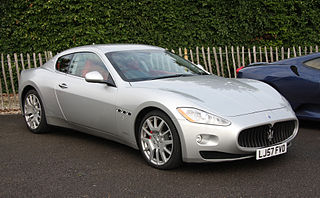
The Maserati GranTurismo and GranCabrio are a series of a grand tourers produced by the Italian automobile manufacturer Maserati from 2007 to 2019. They succeeded the 2-door V8 grand tourers offered by the company, the Maserati Coupé, and Spyder. The model was initially equipped with a 4.2-litre V8 engine developed in conjunction with Ferrari. The GranTurismo platform was derived from Maserati M139 platform of Maserati Quattroporte V, with double-wishbone front and rear suspension. The grand tourer emphasizes comfort in harmony with speed and driver-enjoyment.

The Tatra 97 (T97) is a Czechoslovak mid-size car built by Tatra in Kopřivnice, Moravia from 1936 to 1939.

The Hyundai i30 is a small family car manufactured by the South Korean manufacturer Hyundai Motor Company since 2007. The i30 shares its platform with the Kia Cee'd, available as a three-door hatchback (2012–2017), five-door hatchback, five-door estate and five-door Liftback (2017–present), with a choice of three petrol engines and two diesel engines, either with manual or automatic transmission.

The Tatra 80 is a Czechoslovak luxury full-size car built by Tatra between 1931 and 1935.

The Tatra 603 is a large rear-engined luxury car which was produced by the Czechoslovak company Tatra from 1956 to 1975. It was a continuation of the series of Tatra streamlined sedans which began with the Tatra 77. In Socialist Czechoslovakia, only high-ranking party officials and heads of factories were driven in 603s; the car was also exported to a number of other countries.

The Tatra 57 are a series of two-door compact cars, built by Czechoslovakian company Tatra from 1932. They are popularly known by the nickname "Hadimrška".

The Tatra 75 is a Czechoslovak mid-size car that Tatra introduced in 1933 as the successor to the Tatra 54.

The Tatra 70 is a Czechoslovak luxury car that was made by Tatra at Kopřivnice from 1931 to 1937. It succeeded the Tatra 31.
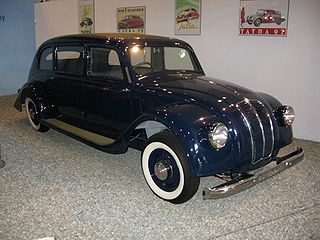
The Tatra 90 is a Czechoslovak prototype mid-size car, made by Tatra in Kopřivnice in 1935.

The I Velká cena Československa was a Grand Prix motor race which was held at Masaryk Circuit on 25 September 1949. The race was won by Peter Whitehead driving a Ferrari 125. Czechoslovak driver Václav Uher died in crash during practice. Giuseppe Farina crashed into spectators in the first lap of the race and killed two of them. Tatraplan of Bruno Sojka was in streamlined configuration.
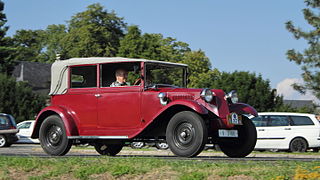
The Tatra 52 is a Czechoslovak mid-size car that was made by Závody Tatra from 1931 to 1939. It was built both at the Tatra factory in Kopřivnice and also under licence at Frankfurt am Main in Germany.
The B. S. Cunningham Company was an automobile company established by Briggs Cunningham. It produced six different models in very small numbers, primarily to be raced at the 24 Hours of Le Mans.